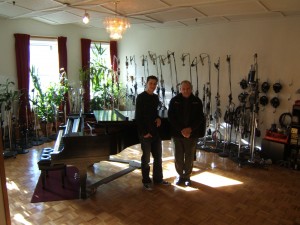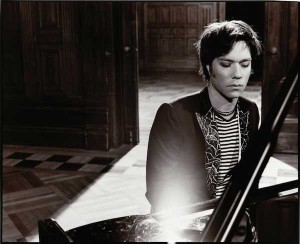Rufus Wainwright & The Making of “Songs for Lulu”: A Tale of Five Pianos at Sear Sound
HELL’S KITCHEN: Only the eclectically exacting environment of Sear Sound would do for the likes of Rufus Wainright. When it came time to record the purely fascinating sounds of the newly released All Days are Nights: Songs for Lulu, NYC’s bastion of sonic succulence was the natural choice.
Consisting only of vocals, piano and the always intriguing songwriting mastery wielded by Wainright, Lulu saw Sear and crew pulling out some unusual stops in their sunlight-drenched Studio C. Five pianos – an 1800’s Steinway C concert grand, Steinway D concert grand, upright Steinway, and two Yamaha 7’ C7’s — were arrayed in the live room, miked and ready to go for Wainright to move to at will as he located the ideal keyboard for the song, mood and persona of the day.
Working with the project’s chief engineer, Tom Schick, and Sear Sound engineer David Schoenwetter, Wainright assembled the intensely arresting 12-track album in a way that put performance – and perfectionism — front and center.
“The fewer elements and people that are involved, the more you’ve got to pay attention to detail, because you only have two things for the listener to focus on,” says Schoenwetter. “So you focus on details much more. You’re trying to capture the music, and capture the performance that best suits the song, and that’s not always the easiest thing to achieve.
“A lot of his songs are really personal, and there’s a lot of emotion involved. We would spend quite a lot of time recording many takes, than listening back and really analyzing everything. You need to present a final product that matches what the artist is hearing in his head, and express the emotion that he felt when he wrote it.
“We spent as much time listening as we did recording. It’s not like when you record a six-piece band, then everyone takes five and you listen and decide to fix the sax solo. It’s really about the performance of the whole song. A lot of these piano parts were quite challenging – Rufus’ material is not really simple, it’s not simple pop music. It’s complex structures, and a lot of his songs were quite fast with a lot of notes. There are many ways you can approach something like that.”
Here’s what it took for Shick and Schoenwetter to tackle Rufus Wainwright’s keyboard team:
PIANO PLETHORA:
“Every one of those pianos sounds dramatically different. The Steinway C that we had – the most popular choice – is from 1894. Age changes the way the wood resonates, and it has a really special character to it. Hearing it on a lot of recordings, it’s really responsive to the player. I’ve heard it sound like many different pianos. I think Rufus was really able to express himself well through that one. That one really sounded like him.
“We did a specific set of closed mics on each piano that did not move, and a stereo mic that was one or two feet outside of whichever piano that we were recording at the time. As well, we had another mic that was at the tail of the piano, where all the bass strings terminate.
“So in other words, every time we recorded the piano, we had the two close mics, a P.O.V. mic which moves with each piano, the low piano mic, and the stereo pair of pics that stayed in the room capturing the farther room sound – the ambience. Those far mics were Neumann CMV563’s: vintage tube mics that have bayonette-style capsules which you can change for different situations.”
THE STEINWAY C:
“The close mics on the Steinway C that we used the most were two Blue mics: the Bottle Rocket Stage Two tube microphone, which is relatively new, with a C12 capsule on each.
“The close room mic that we moved from piano to piano was the AEA R-88 stereo ribbon mic, which is really nice. With stereo ribbon mics you get the Blumlein configuration, where there is a 90 degree angle beween each ribbon, and they both pick up sound equally from the front and back. So you get what the instrument is projecting directly from the front, plus you also get the ambience of the room being picked up from the back. It’s a very natural sound.
“The close mics tend to be brighter with a lot of attack, and when you blend a stereo ribbon mic with that it gives a nice fullness and makes it a little more natural. The mic that we add on the low strings, a condenser Microtech Gefell UM70, also adds to the fullness of everything in the low register.”
THE STEINWAY D:
“Close mics for this piano were the AKG C24 stereo tube mic. The AKG C12 tube condenser mic is a classic, and this is a stereo version of that. One capsule is fixed, and the top capsule rotates from 0-180 degrees, so you can change the stereo image. Having a stereo mic like that makes the phase cohenercy between two sides as perfect as it can be. It’s a really beautiful stereo mic, and rare to find them in good condition. That also has adjustable polar patterns for each capsule, with individual power supply.
“We use this as an X/Y pair, where each capsule is cardioid with a 90-degree angle between them. You can do that with any two microphones if you want to, but you need the capsules to be as close as possible to minimize any phase differences between them.”
THE STEINWAY UPRIGHT:
“Here we used two Neumann M582s, just inside the lid there. Those are really nice because they’re omni-directional. They have a bright, exciting high-end response.”
THE YAMAHA C7:
“For each of the 7’ Yahama C7 pianos we used a pair of Neumann U67’s, which are also cardioid. The 67’s are really versatile mics. They tend to be really fat, and since Yamahas tend to be a bit bright, it kind of fattens them up a little bit — the C12’s on the Yamahas probably would not have been as pleasant.”
CHARTING THE PIANO SIGNAL PATH:
“All of the mics went through our custom console with all-Avalon EQs and mic preamps. As far as compressors, we inserted a Chandler TG1 stereo compressor that we used on the close mics. The low mics on the piano tail when through a Tube-Tech CL1B. The room mics were not compressed.
“Everything – piano and vocals – were recorded at 88.2 kHz/24-bit. The converters were the Digidesign 192’s, as well as eight channels of Mytek. The most important thing about those is not just the converters, but the clock is really great. We use that as the master clock, rather than the Pro Tools clock, which has a lot of jitter.”
RUFUS ON THE MIC – THE VOCAL SIGNAL PATH:
“The first day we went through and tried out a bunch of vocal mics — each one has a different character. Rather than pushing the EQ button, the best way to do it is to keep trying different mics until you find the best match for whatever source you’re capturing.
“The mic we settled on was the Neumann M49. It’s one of the warmest tube mics we have. An AKG C12 or Neumann U47 for example, are both very bright, and for someone that really projects a lot with his particular singing style, they didn’t suit as well. The M49 captures a lot of detail in the high end, but it’s still warm and doesn’t sound harsh.
“Especially when you’re recording piano and vocals together, you have to be really concerned with isolation between the piano and vocal. This mic allowed us to do that. It has an independent power supply, and you can vary the polar pattern by changing the voltage to the back plate of the capsule – instead of just being cardioid or omni, it can be variable between every polar pattern. So halfway between caridoid and figure 8 you get a very tight cardioid pattern that allows you to reject a lot of the piano.
“We tried many different preamps and ended up using Tube-Tech preamps. The Tube-Tech MP1A is really warm and thickened the sound a little bit – it definitely does have a character to it! It’s not the most transparent thing, but for this it was perfect.
“From there we went into a tube compressor, the Pendulum Audio 6386. The attack and release time, and the way it compresses was really pleasing and quite smooth – we were able to get away with a decent amount of gain reduction without it sounding too noticeable. This one that Tom has just sounds really nice. The old 6386 tubes are the ones the Fairchild used – those were the tubes that controlled the gain reduction, which is a rare characteristic.
“Rather than going through the console, we patched that right to Pro Tools for the most direct path possible: mic to pre to compressor to tape.”
NO FEAR: SONGS FOR LULU WAS AT HOME AT SEAR
“Details really being quite important on a project, that’s probably why Rufus Wainright came to Sear Sound. We focus on details quite a lot here, but the main focus of this studio – the staff and especially Walter Sear – is capturing the sound and music of the performance as much as possible. That’s really what matters.” — David Weiss
Please note: When you buy products through links on this page, we may earn an affiliate commission.








